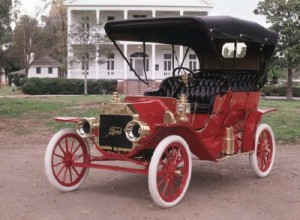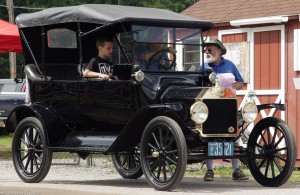Model T Ford Facts
By today’s standards, Henry Ford’s Model T has many unusual characteristics. Before you can jump into the driver’s seat, you have to turn a hand crank at the front of the car to start it.
This is a hazardous process as the hand crank can break your thumb if the engine backfires, and if the throttle lever on the steering column is not set properly it will run you over as soon as it starts. Fortunately, an optional electric starter was introduced in 1919.
The Model T has three foot pedals and a floor lever. To drive off, you increase the throttle lever, move the floor lever forwards from its neutral position and depress the clutch foot pedal on the left. As you pick up speed, you can move from first to second gear by releasing pressure on the clutch pedal.
To stop, simply reduce the throttle, press down the clutch pedal, depress the brake foot pedal on the right and put the floor lever into neutral. To go backwards you keep the floor lever in neutral and press down the middle reverse foot pedal.
Early versions of the car had brass acetylene lamps, and its ten-gallon fuel tank was mounted under the front seat. As this fed petrol to the carburetor using gravity, the Model T could not climb steep hills if the tank was low on fuel. The solution to this was to drive up hill in reverse.
 Its engine is front mounted, and features four cylinders in one en bloc casting. This simple engine is relatively easy to run and maintain.
Its engine is front mounted, and features four cylinders in one en bloc casting. This simple engine is relatively easy to run and maintain.
The first models were runabouts with open bodies and a hood that can be folded down. Lots of different car and truck bodies were later fitted to the Model T chassis by Ford and other companies.
Since the Model T was equally at home in town or as an off-road farm workhorse, and available at the cheapest price possible, it quickly dominated the USA and made motoring an essential part of our lives.
Mass production
The revolutionary methods used by Ford opened up a world of possibilities.
Mass production using a moving assembly line was the key innovation that made the Model T so successful. Car production had been largely pitched at the luxury market with hand-built bespoke models being the norm. Henry Leland, who worked for Cadillac, pioneered the standardization of car components, and moving production lines were used in Chicago slaughterhouses.
 The genius of Ford was to integrate these methods and reduce the production of the Model T to 84 key areas. The chassis of the car was run along a track and each worker carried out a very simple and repetitive production task, before it was moved on to the next work area.
The genius of Ford was to integrate these methods and reduce the production of the Model T to 84 key areas. The chassis of the car was run along a track and each worker carried out a very simple and repetitive production task, before it was moved on to the next work area.
The engine and other components were made in a similar manner before being added to the chassis. This slavish process made it possible to reduce the time to make one Model T from 12 hours eight minutes to 93 minutes.
As early as 1914, Ford’s mass production techniques produced 300,000 cars with 13,000 workers compared to the 66,350 workers at all the other car companies who only produced 280,000 cars.
Read also You can paint it any color, so long as it’s black , Model T Ford Club of America and Model T Ford Club International User Forum
From 27 September 1908 till the end of production on 26 May 1927, 15 million Model Ts were made. The Model T met and exceeded Henry Ford’s vision of creating a simply designed car using the best materials at a price affordable to everyone.
